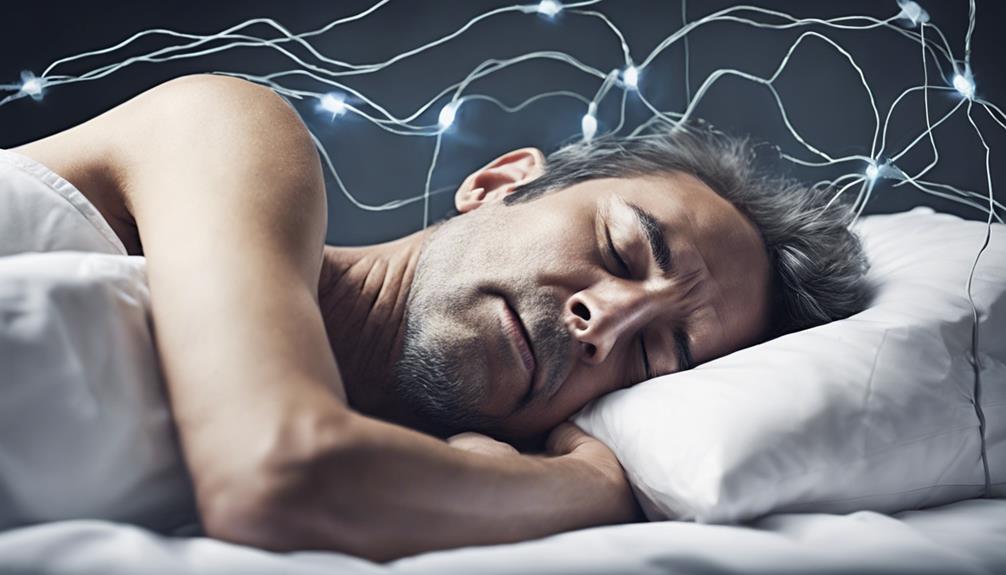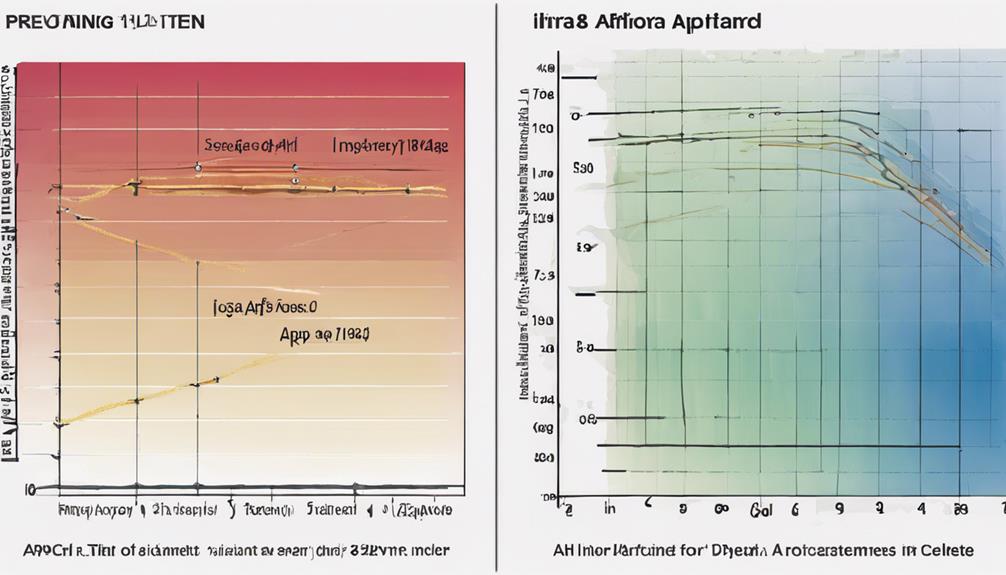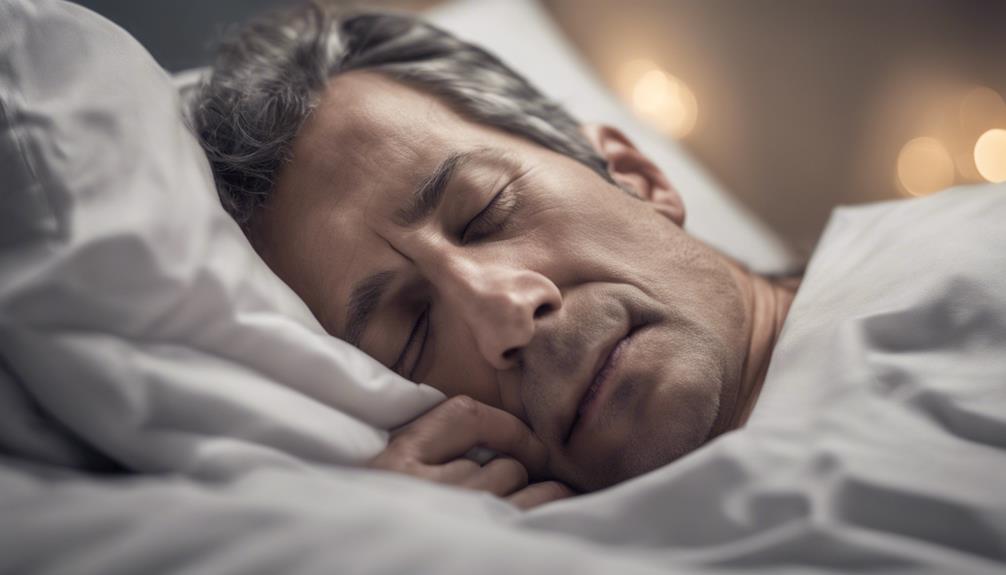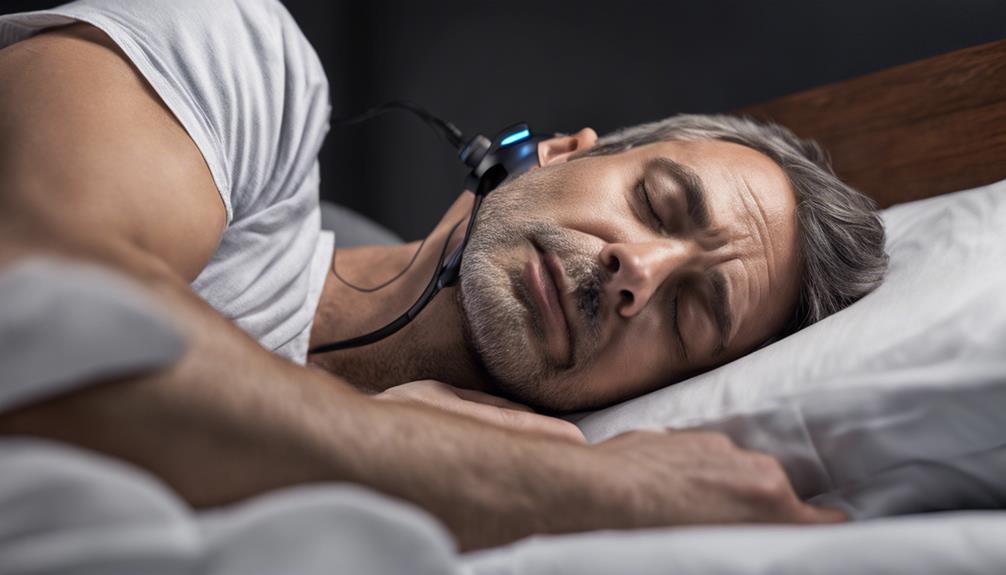Inspire Therapy guarantees ideal outcomes by stimulating the hypoglossal nerve, which prevents the tongue from obstructing the airway during sleep. It reduces apnea events by up to 79%, minimizing snoring and daytime drowsiness. Surgeons implant the device through three small incisions and activate it after approximately four weeks. Patients may experience temporary side effects like bruising but recover within days. Long-term effects demonstrate a promising 66% decrease in Apnea-Hypopnea Index (AHI) score, enhancing sleep quality. Additionally, follow-up appointments secure excellent results. Inspire Therapy offers enduring benefits for managing sleep disturbances and providing relief.
Key Takeaways
- Inspire Therapy stimulates the hypoglossal nerve to prevent tongue collapse during sleep.
- It reduces sleep apnea events by up to 79% and decreases snoring and daytime sleepiness.
- The implantation process involves three small incisions and post-operative care for optimal results.
- Regular follow-up appointments monitor stimulation levels and ensure lasting benefits.
- Inspire Therapy offers a durable solution for sleep-disordered breathing with significant long-term symptom improvement.
Mechanism of Inspire Therapy
Inspire Therapy functions by actively stimulating the hypoglossal nerve to control tongue and airway muscles during sleep. When we sleep, our muscles relax, including those in the tongue and airway.
For some individuals, this relaxation causes the tongue to collapse backward, obstructing the airway and leading to sleep apnea. Inspire therapy combats this by providing gentle stimulation to the hypoglossal nerve, which then moves the tongue forward, keeping the airway open.
This stimulation is like a personalized wake-up call for the tongue muscles, ensuring they stay active during sleep to prevent obstructions.
Nerve Stimulation for Sleep Apnea

Nerve stimulation plays a pivotal role in addressing sleep apnea by specifically targeting the hypoglossal nerve to regulate tongue and airway muscles during sleep. With Inspire therapy, this targeted stimulation helps keep the airway open, reducing sleep apnea events by up to 79%.
By controlling these muscles, the Inspire device decreases snoring and daytime sleepiness, leading to improved overall health. The Inspire device is user-friendly, as it can be adjusted using a handheld remote to customize stimulation strength based on individual needs.
This innovative approach tackles the root cause of sleep apnea, enhancing sleep quality and overall well-being. By focusing on nerve stimulation through the hypoglossal nerve, Inspire therapy offers a non-invasive solution that can notably impact the lives of those struggling with sleep apnea.
Implantation Process of Inspire Device
During the implantation process of the Inspire device, surgeons make three small incisions under general anesthesia. This procedure allows for the placement of the device that will help manage sleep apnea.
Following the surgery, the device is typically activated around four weeks later to begin its therapeutic effects.
Surgical Implant Procedure
Upon undergoing the surgical implant procedure for the Inspire device, three small incisions are made under general anesthesia. These incisions allow for the placement of the device components, including the pulse generator and sensing lead.
Following the procedure, a period of post-operative care is important to monitor healing and minimize any discomfort. It's necessary to attend scheduled follow-up appointments to assess the stimulation effectiveness and address any concerns.
While implant-related complications are rare, it's imperative to be aware of potential risks and promptly report any unusual symptoms to healthcare providers. Temporary side effects like bruising and tingling along the tongue may occur but typically resolve as the body adjusts to the device.
Device Activation Process
After the surgical implant procedure for the Inspire device, the activation process involves a scheduled post-operative sleep study to confirm appropriate stimulation. This study guarantees that the device is effectively treating your sleep apnea by delivering the necessary stimulation to keep your airway open during sleep.
Complications from the implantation process are rare, with less than a 1% reported rate of serious issues. Some temporary side effects like bruising and tingling along the tongue may occur post-implantation, but these typically subside as you heal.
Device activation usually takes place around four weeks after the implantation to allow for proper healing. By following through with the post-operative sleep study, you can be confident that the Inspire device is working optimally to improve your sleep apnea symptoms.
Impact on Apnea-Hypopnea Index (AHI)

Improving the Apnea-Hypopnea Index (AHI) is a vital objective of Inspire therapy, which has demonstrated a substantial 66% reduction in AHI after 12 months of consistent use. This therapy is designed to address obstructive sleep apnea by decreasing the severity of breathing pauses during sleep. The impact of Inspire therapy on AHI and overall sleep quality is significant, as evidenced by clinical studies. In addition to improving the Apnea-Hypopnea Index, Inspire therapy enhances overall patient outcomes by reducing symptoms such as daytime fatigue and improving cardiovascular health. This is particularly important given the established link between sleep apnea and AFib, where untreated sleep apnea significantly increases the risk of atrial fibrillation and its associated complications. By addressing the root causes of obstructive sleep apnea, Inspire therapy not only improves sleep quality but also contributes to broader health benefits, reducing the burden of comorbid conditions.
Here are some key points about the impact of Inspire therapy on the Apnea-Hypopnea Index (AHI):
- AHI Reduction: Inspire therapy has been proven to reduce the AHI score by 66% over the course of 12 months, showing a remarkable improvement in sleep apnea management.
- ODI Improvement: In a study, 75% of participants experienced a minimum 25% decrease in the oxygen desaturation index (ODI) with Inspire therapy, highlighting its effectiveness in enhancing oxygen levels during sleep.
- Median Score Reduction: The median AHI score decreased by 68% and the median ODI score dropped by 70% in individuals utilizing Inspire therapy, underscoring its effectiveness in improving sleep-related breathing difficulties.
Inspire therapy, through its impact on AHI, plays a pivotal role in enhancing the quality of sleep and overall well-being for individuals struggling with obstructive sleep apnea.
Recovery Period After Inspire Treatment

Shifting from the influence of Inspire therapy on the Apnea-Hypopnea Index (AHI), the recovery period post-Inspire treatment is an essential aspect that individuals undergoing this therapy should be aware of. After the Inspire implantation procedure, basic recovery typically takes a few days. Most patients can gradually resume strenuous activities within about two weeks.
It's important to consult with your doctor before activating the device, which usually occurs around 30 days after the implantation. Additionally, annual check-ups with your doctor are recommended to make sure the Inspire device is functioning correctly and the settings are appropriate for your needs. These check-ups help in monitoring the effectiveness of the therapy and making any necessary adjustments.
Follow-Up Care for Inspire Patients

Regular follow-up care is essential for patients who've undergone Inspire therapy.
Consult with your doctor before activating the device post-surgery, typically around 30 days after the procedure.
Annual check-ups help guarantee the device is working well and settings are appropriate for effective treatment.
Post-Implant Monitoring
How do doctors guarantee peak functionality and settings of the Inspire therapy device during post-implant monitoring for patients?
Post-implant monitoring for Inspire therapy involves annual checks to make sure the device is working at its best. Here's how this follow-up care helps support patients:
- Verification of Proper Device Activation: Doctors make certain the device is activated correctly to provide effective treatment.
- Adjustments for Effective Treatment: Any necessary changes to the device settings are implemented to maximize its effectiveness in managing sleep apnea.
- Monitoring Battery Lifespan: Regular checks on the battery, which lasts around 7-10 years, ensure continuous therapy for long-term sleep apnea management.
Regular sleep studies also play an important role in tracking the effectiveness of Inspire therapy in reducing sleep apnea symptoms over time.
Lifestyle Adjustments Support
To ensure optimal outcomes post-Inspire therapy, incorporating lifestyle adjustments is essential for supporting patients in managing sleep apnea effectively. Maintaining a healthy weight through proper diet and exercise plays a pivotal role in enhancing the benefits of Inspire therapy.
Additionally, practicing proper sleep hygiene, like maintaining a consistent sleep schedule and creating a comfortable sleep environment, can optimize the results of the treatment. Engaging in stress management techniques, such as relaxation exercises, further supports the positive outcomes of Inspire therapy for sleep apnea.
Long-Term Efficacy Checkups
Maintaining the ongoing effectiveness of Inspire therapy in treating sleep apnea involves scheduling annual follow-up appointments with your doctor to assess the device and its settings. During these checkups, your doctor will focus on several key areas to preserve the long-term efficacy of the treatment:
- Evaluating the stimulation levels to confirm they're appropriately targeting the airway.
- Checking the battery life and overall performance of the device to ensure consistent functioning.
- Adjusting device settings as needed to optimize treatment outcomes and effectively manage sleep apnea.
Regular monitoring of the Inspire device through these annual follow-up appointments is crucial for addressing any issues promptly and ensuring successful long-term management of sleep apnea.
Insurance Coverage for Inspire Therapy

With over 250 insurance companies covering Inspire therapy, access to this treatment option is greatly broadened, making it more attainable for individuals seeking relief from obstructive sleep apnea. Approval for the procedure is typically guaranteed before moving forward, reducing the financial burden on patients. Most commercial insurers, Medicare, and Veterans Affairs cover Inspire therapy, increasing its affordability and making it a viable option for many. This insurance coverage not only helps individuals manage snoring and sleep issues effectively but also offers a better chance of addressing sleep apnea and improving overall health.
| Insurance Coverage for Inspire Therapy | Benefits |
|---|---|
| Covered by over 250 insurance companies | Accessible treatment option |
| Guaranteed before procedure | Reduced financial burden |
| Most commercial insurers, Medicare, Veterans Affairs coverage | Increased affordability |
| Helps manage snoring and sleep issues effectively | Improves overall health |
Comparing Inspire Therapy to CPAP

When comparing Inspire therapy to CPAP, individuals with obstructive sleep apnea have a mask-free alternative that stimulates airway muscles to improve breathing during sleep. Inspire therapy utilizes nerve stimulation to move the tongue forward, keeping the airway open, while CPAP involves wearing a mask that delivers pressurized air to prevent airway collapse.
- Treatment Approach: Inspire therapy targets the root cause by stimulating airway muscles, whereas CPAP focuses on providing continuous air pressure to keep the airway open.
- Comfort and Freedom: Inspire therapy allows individuals to sleep without a mask, offering greater comfort and freedom of movement compared to CPAP.
- Effectiveness: Research shows that Inspire therapy can reduce the apnea-hypopnea index (AHI) by 66% after 12 months, making it a promising option for individuals with moderate to severe sleep apnea who struggle with CPAP compliance.
Long-Term Efficacy of Inspire Treatment

Long-term studies confirm the sustained effectiveness of Inspire treatment in reducing AHI scores and improving sleep apnea symptoms over an extended period. Patients undergoing Inspire therapy experience lasting benefits, with significant reductions in nighttime breathing disturbances and improved sleep quality maintained even after years of treatment initiation. This therapy provides a durable solution for obstructive sleep apnea, offering long-lasting relief from sleep-disordered breathing. The table below highlights the key findings regarding the long-term efficacy of Inspire treatment:
| Key Findings | Importance |
|---|---|
| Significant AHI Reduction | Sustained improvement in breathing patterns over time |
| Improved Sleep Apnea Symptoms | Long-lasting relief from sleep disturbances |
| Lasting Benefits | Continued reduction in snoring and enhanced sleep quality |
Inspire therapy stands out as an effective long-term option for individuals seeking to manage obstructive sleep apnea and improve their overall sleep health.
Frequently Asked Questions
What Is the Downside to Inspire Sleep?
The downside to Inspire therapy may include temporary bruising and tingling post-surgery, with rare serious complications. However, the benefits of up to 79% reduction in sleep apnea, improved snoring, daytime alertness, and sleep quality outweigh these risks for many patients.
How Exactly Does Inspire Work for Sleep Apnea?
Inspire therapy works by stimulating throat muscles during sleep, keeping the airway open to reduce sleep apnea events. The FDA-approved implantable device functions like a pacemaker, controlled with a handheld remote for easy management.
Does Inspire Work as Well as Cpap?
Inspire therapy performs comparably to CPAP in treating sleep apnea, exhibiting substantial efficacy. With a 79% reduction in apnea events and significant improvements in AHI and ODI, Inspire offers a promising alternative for managing sleep apnea effectively.
What Is the Success Rate of Inspire Therapy?
We've seen a significant success rate with Inspire therapy, showing a 66% reduction in AHI scores and 75% experiencing a 25% drop in ODI. Through sleep studies, doctors monitor progress, enhancing breathing and effectively alleviating obstructive sleep apnea symptoms.
Conclusion
To sum up, Inspire therapy offers a groundbreaking treatment for sleep apnea by using nerve stimulation to keep airways open during sleep. This innovative approach has shown to markedly reduce the Apnea-Hypopnea Index (AHI) and improve quality of life for patients.
With proper implantation and follow-up care, Inspire therapy can provide long-term relief for those struggling with sleep apnea. Embracing this advanced technology can lead to a healthier and more restful night's sleep.









